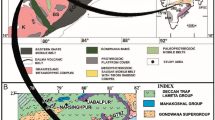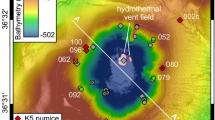Abstract
Petrological and textural properties of lacustrine sediments from Upper Klamath Lake, Oregon, reflect changing input volumes of glacial flour and thus reveal a detailed glacial history for the southern Cascade Range between about 37 and 15 ka. Magnetic properties vary as a result of mixing different amounts of the highly magnetic, glacially generated detritus with less magnetic, more weathered detritus derived from unglaciated parts of the large catchment. Evidence that the magnetic properties record glacial flour input is based mainly on the strong correlation between bulk sediment particle size and parameters that measure the magnetite content and magnetic mineral freshness. High magnetization corresponds to relatively fine particle size and lower magnetization to coarser particle size. This relation is not found in the Buck Lake core in a nearby, unglaciated catchment. Angular silt-sized volcanic rock fragments containing unaltered magnetite dominate the magnetic fraction in the late Pleistocene sediments but are absent in younger, low magnetization sediments. The finer grained, highly magnetic sediments contain high proportions of planktic diatoms indicative of cold, oligotrophic limnic conditions. Sediment with lower magnetite content contains populations of diatoms indicative of warmer, eutrophic limnic conditions. During the latter part of oxygen isotope stage 3 (about 37–25 ka), the magnetic properties record millennial-scale variations in glacial-flour content. The input of glacial flour was uniformly high during the Last Glacial Maximum, between about 21 and 16 ka. At about 16 ka, magnetite input, both absolute and relative to hematite, decreased abruptly, reflecting a rapid decline in glacially derived detritus. The decrease in magnetite transport into the lake preceded declines in pollen from both grass and sagebrush. A more gradual decrease in heavy mineral content over this interval records sediment starvation with the growth of marshes at the margins of the lake and dilution of detrital material by biogenic silica and other organic matter.
Similar content being viewed by others
References
Adam D.P., Bradbury J.P., Carter C., Dean W.E., Hakala K., McGann M., Reynolds R.L., Rieck H.J., Roberts A.P., Rosenbaum J.G., Sarna-Wojcicki A.M., Schiller K. and Whitlock C. 1995. Status report on cores taken in 1991–1992 in the Upper Klamath Basin and vicinity, Oregon and California. In: Adam D.P., Bradbury J.P., Dean W.E., Gardner J.V. and Sarna-Wojcicki A.M. (eds), Report of the 1994 Workshop on the Correlation of Marine and Terrestrial Records of Climate Changes in the Western United States. US Geological Survey Open-file Report 95-34, pp. 13–29.
Bacon C.R. 1983. Eruptive history of Mount Mazama and Crater Lake caldera, Cascade Range, USA. J. Volcanol. Geothermal Res. 18: 57–115.
Bacon C.R., Lanphere M.A. and Champion D.E. 1999. Late Quaternary slip rate and seismic hazards of the West Klamath Fault zone near Crater Lake, Oregon Cascades. Geology 27: 43–46.
Benson L.V., Burdett J.W., Kashgarian M., Lund S.P., Phillips F.M. and Rye R.O. 1996. Climatic and hydrologic oscillations in the Owens Lake basin and adjacent Sierra Nevada, California. Science 274: 746–749.
Benson L.V. and Thompson R.S. 1987. Lake-level variation in the Lahontan Basin for the past 50,000 years. Quaternary Res. 28: 69–85.
Bischoff J.L., Fitts J.P. and Fitzpatrick J.A. 1997. Responses of sediment geochemistry to climate change in Owens Lake sediment: An 800-k.y. record of saline/fiesh cycles in core OL-92. In: Smith G.I. and Bischoff J.L. (eds), An 800,000-Year Paleoclimate Record From core OL-92, Owens Lake, Southeast California. Geological Society of America, Special Paper 317, pp. 37–47.
Bradbury J.P. 1991. The late Cenozoic diatom stratigraphy and paleolimnology of Tule Lake, Siskiyou Co., California. J. Paleolimnol. 6: 205–255.
Bradbury J.P., Colman S.M. and Reynolds R.L. 2004a. The history of recent Limnological changes and human impact on Upper Klamath Lake, Oregon. J. Paleolim. 31: 151–165 (this issue).
Bradbury J.P., Colman S.M. and Dean W.E. 2004b. Limnological and climatic environments at Upper Klamath Lake, Oregon during the past 45,000 years. J. Paleolim. 31: 167–188 (this issue).
Carver G.A. 1972. Glacial geology of the Mountain Lakes Wilderness and adjacent parts of the Cascade Range. PhD dissertation, University of Washington Oregon. Seattle, 76 pp.
Colman S.M., Bradbury J.P., McGeehin J.P., Holmes C.W., Edginton D. and Sarna-Wojcicki A.M. 2004. Chronology of sediment deposition in Upper Klamath Lake, Oregon. J. Paleolim. 31: 139–149 (this issue).
Colman S.M., Rosenbaum J.G., Reynolds R.L. and Sarna-Wojcicki A.M. 2000. Post-Mazama (7 ka) faulting beneath Upper Klamath Lake, Oregon. Bull. Seismological Soc. Am. 90: 243–247.
Drewry D. 1986. Glacial Geologic Processes. Edward Arnold, London, 276 pp.
Kerwin M.W. 1996. A regional stratigraphic isochron (ca. 8000 14C yr B.P.) from final deglaciation of Hudson Strait. Quaternary Res. 46: 89–98.
Lovley D.R., Stolz J.F., Nord G.L.Jr. and Phillips E.J.P. 1987. Anaerobic production of magnetite by a dissimilatory iron-reducing microorganism. Nature 330: 252–254.
McKee E.H., Duffield W.A. and Stern R.J. 1983. Late Miocene and early Pliocene basaltic rocks and their implications for crustal structure, northeastern California and south-central Oregon. Geol. Soc. Am. 94: 292–302.
Mortlach R.A. and Froelich P.N. 1989. A simple method for the rapid determination of biogenic opal in pelagic marine sediments. Deep-Sea Res. 36: 1415–1424.
Muhs D.R. 1983. Airborne dust fall on the California Channel Islands, USA. J. Arid Environ. 6: 223–238.
Muhs D.R., Bush C.A., Stewart K.C., Rowland T.R. and Crittenden R.D. 1990. Geochemical evidence of Saharan dust parent material for soils developed on Quaternary limestones of Caribbean and western Atlantic islands. Quaternary Res. 33: 157–177.
Oviatt C.G. 1997. Lake Bonneville fluctuations and global climate change. Geology 25: 155–158.
Petersen N., Von Dobonek T. and Vali H. 1986. Fossil bacterial magnetite in deep-sea sediments from the South Atlantic Ocean. Nature 320: 611–615.
Prentice I.C. 1986. Vegetation responses to past climatic variation. Vegetatio 67: 131–141.
Reynolds R.L., Belnap J. and Reheis M.C. 2001. Aeolian dust in Colorado Plateau soils: Nutrient inputs and recent change in source. Proc. Natl. Acad. Sci. USA 98: 7123–7127.
Reynolds R.L., Rosenbaum J.G., Bradbury J.P., Best P.J., Adam D.P. and Drexler J. 1996. Late Quaternary glacial history of southern Oregon interpreted from sediment magnetism of Upper Klamath Lake. Abstracts with Program, Geological Society of America 1996 Annual Meeting: A-504.
Reynolds R.L., Rosenbaum J.G., Van Metre P., Tuttle M.L., Callender E. and Goldin A. 1999. Greigite (Fe3S4) as an indicator of drought — the 1912–1994 magnetic record from White Rock Lake, Dallas, Texas. J. Paleolimnol. 21: 193–204.
Roberts A.P., Reynolds R.L., Verosub K.L. and Adam D.P. 1996. Environmental magnetic implications of greigite (Fe3S4) formation in a 3 m.y. lake sediment record from Butte Valley, northern California. Geophys. Res. Lett. 23: 2859–2862.
Rosenbaum J.G. and Reynolds R.L. 2004a. Record of Late Pleistocene glaciation and deglaciation in the southern Cascade Range: II. Flux of glacial flour in a sediment core from Upper Klamath Lake. J. Paleolim. 31: 235–252 (this issue).
Rosenbaum J.G. and Reynolds R.L. 2004b. Basis for paleoenvironmental interpretation of magnetic properties of sediment from Upper Klamath Lake (Oregon): effects of weathering and mineralogical sorting. J. Paleolim. 31: 253–265 (this issue).
Rosenbaum J.G., Reynolds R.L., Adam D.P., Drexler J., Sarna-Wojcicki A.M. and Whitney G.C. 1996. Record of middle Pleistocene climate change from Buck Lake, Cascade Range, southern Oregon-Evidence from sediment magnetism, trace-element geochemistry, and pollen. Geol. Soc. Am. Bull. 108: 1328–1341.
Rosenbaum J.G., Reynolds R.L., Rapp J., Kerwin M., Drexler J. and Adam D.A. 1997. Sediment magnetic, paleomagnetic, geochemical, and grain size data from lacustrine sediment in a core from Upper Klamath Lake, Oregon. US Geological Survey Open-file Report 97-516, 49 pp.
Sherrod D.R. 1991. Geologic map of a part of the Cascade Range between latitudes 43°-44°, central Oregon. US Geological Survey Miscellaneous Investigation Map I-1891.
Smith J.G. 1988. Geologic map of the Pelican Butte quadrangle, Klamath County, Oregon. US Geological Survey map GQ-1653, scale 1: 62,500.
Smith G.I., Bischoff J.L. and Bradbury J.P. 1997. Synthesis of the paleoclimate record from Owens Lake core OL-92. In: Smith G.I. and Bischoff J.L. (eds), An 800,000-Year Paleoclimate Record from Core OL-92, Owens Lake, Southeast California. Geological Society of America, Special Paper 317, pp. 143–160.
Snowball I.F. 1994. Bacterial magnetite and the magnetic properties of sediments in a Swedish lake. Earth Planetary Sci. Lett. 126: 129–142.
Snowball I.F. and Thompson R. 1990. A stable chemical remanence in Holocene sediments. J. Geophys. Res. 95: 4471–4479.
Stoermer E.F. and Smol J.P. 1999. The Diatoms: Applications for the Environmental and Earth Sciences. Cambridge University Press, Cambridge, 484 pp.
Thompson R. and Oldfield F. 1986. Environmental Magnetism. Allen & Unwin, London, 227 pp.
Verosub K.L. and Roberts A.P. 1995. Environmental magnetism: Past, present, and future. J. Geophys. Res. 100: 2175–2192.
Walker G.W. and MacLeod N.S. 1991. Geologic map of Oregon. US Geological Survey.
Webb T.III 1986. Is vegetation in equilibrium with climate change? How to interpret late-Quaternary pollen data. Vegetatio 67: 75–91.
Winchester J.A. and Floyd P.A. 1977. Geochemical discrimination of different magma series and their differentiation products using immobile elements. Geochem. Geol. 20: 325–343.
Author information
Authors and Affiliations
Corresponding author
Rights and permissions
About this article
Cite this article
Reynolds, R.L., Rosenbaum, J.G., Rapp, J. et al. Record of Late Pleistocene Glaciation and Deglaciation in the Southern Cascade Range. I. Petrological Evidence from Lacustrine Sediment in Upper Klamath Lake, Southern Oregon. Journal of Paleolimnology 31, 217–233 (2004). https://doi.org/10.1023/B:JOPL.0000019230.42575.03
Issue Date:
DOI: https://doi.org/10.1023/B:JOPL.0000019230.42575.03




